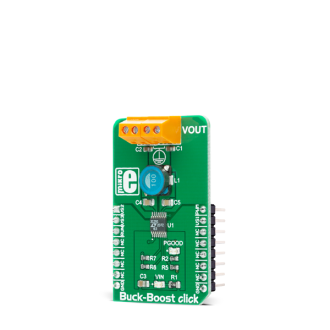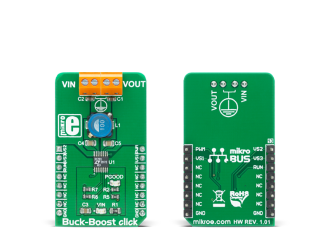
We strongly encourage users to use Package manager for sharing their code on Libstock website, because it boosts your efficiency and leaves the end user with no room for error. [more info]

Rating:
Author: MIKROE
Last Updated: 2019-01-09
Package Version: 1.0.0.1
mikroSDK Library: 1.0.0.0
Category: Buck-Boost
Downloaded: 9184 times
Not followed.
License: MIT license
Buck-Boost click features LTC3129-1, a buck-boost DC/DC conversion integrated circuit from Linear Technology®. The click supports wide input voltage range and can output eight discrete regulated voltage levels, selectable by the digital output voltage selection pins, ranging from 2.5V to 15V.
Do you want to subscribe in order to receive notifications regarding "Buck Boost click" changes.
Do you want to unsubscribe in order to stop receiving notifications regarding "Buck Boost click" changes.
Do you want to report abuse regarding "Buck Boost click".


Library Description
The library covers all the necessary functions to control Buck Boost Click board.
This library contains drivers for set the output value of
2500 mV, 3300 mV, 4100 mV, 5000 mV, 6900 mV, 8200 mV, 12000 mV and 15000 mV
to the converter LTC3129-1 on Buck Boost Click.
Key functions:
void buckboost_defaultConfig() - Set default configuration function.void buckboost_set2500mV() - Set the output voltage of 2500 mV function.void buckboost_set15000mV() - Set the output voltage of 15000 mV functionExamples description
The application is composed of the three sections :
void applicationTask()
{
mikrobus_logWrite( " Set Output Voltage of 2500 mV ", _LOG_LINE );
mikrobus_logWrite( "--------------------------------", _LOG_LINE );
buckboost_set2500mV();
Delay_ms( 5000 );
mikrobus_logWrite( " Set Output Voltage of 3300 mV ", _LOG_LINE );
mikrobus_logWrite( "--------------------------------", _LOG_LINE );
buckboost_set3300mV();
Delay_ms( 5000 );
mikrobus_logWrite( " Set Output Voltage of 4100 mV ", _LOG_LINE );
mikrobus_logWrite( "--------------------------------", _LOG_LINE );
buckboost_set4100mV();
Delay_ms( 5000 );
mikrobus_logWrite( " Set Output Voltage of 5000 mV ", _LOG_LINE );
mikrobus_logWrite( "--------------------------------", _LOG_LINE );
buckboost_set5000mV();
Delay_ms( 5000 );
mikrobus_logWrite( " Set Output Voltage of 6900 mV ", _LOG_LINE );
mikrobus_logWrite( "--------------------------------", _LOG_LINE );
buckboost_set6900mV();
Delay_ms( 5000 );
mikrobus_logWrite( " Set Output Voltage of 8200 mV ", _LOG_LINE );
mikrobus_logWrite( "--------------------------------", _LOG_LINE );
buckboost_set8200mV();
Delay_ms( 5000 );
mikrobus_logWrite( " Set Output Voltage of 12000 mV ", _LOG_LINE );
mikrobus_logWrite( "--------------------------------", _LOG_LINE );
buckboost_set12000mV();
Delay_ms( 5000 );
mikrobus_logWrite( " Set Output Voltage of 15000 mV ", _LOG_LINE );
mikrobus_logWrite( "--------------------------------", _LOG_LINE );
buckboost_set15000mV();
Delay_ms( 5000 );
}
Other mikroE Libraries used in the example:
GPIOUARTAdditional notes and information
Depending on the development board you are using, you may need USB UART click, USB UART 2 click or RS232 click to connect to your PC, for development systems with no UART to USB interface available on the board. The terminal available in all MikroElektronika compilers, or any other terminal application of your choice, can be used to read the message.